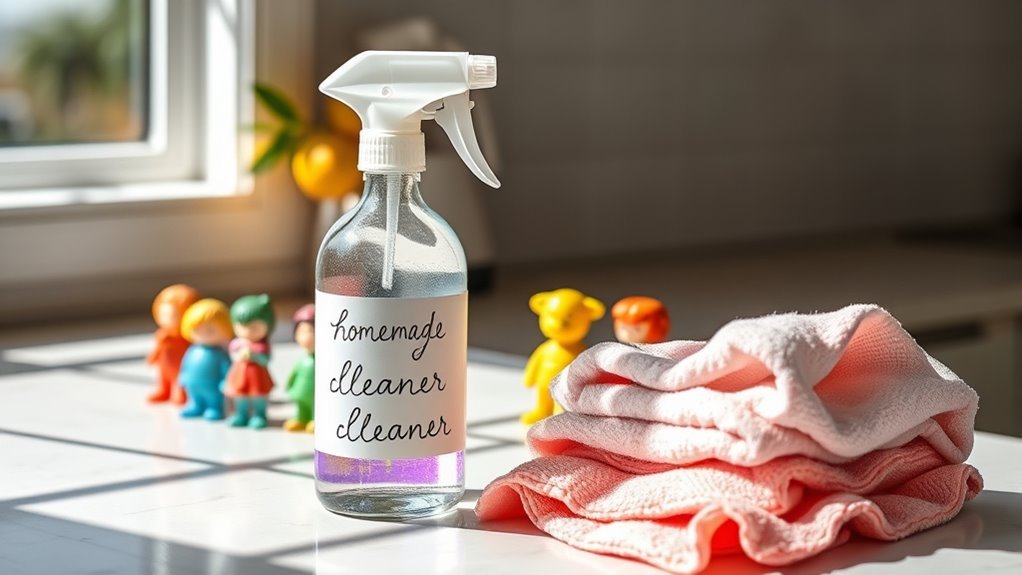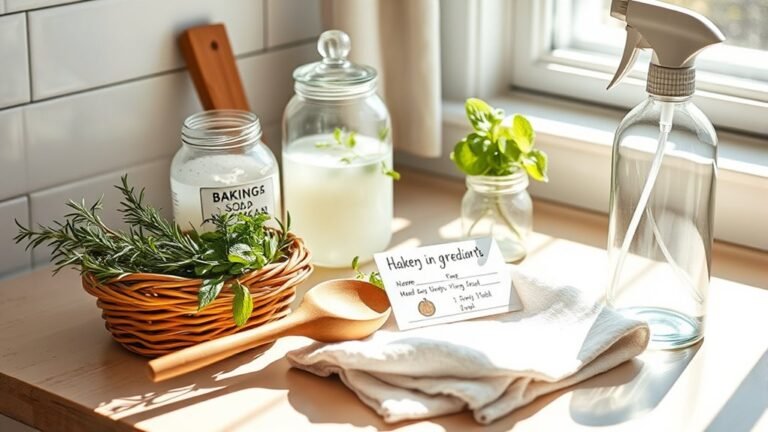DIY Cleaner for Toys Surfaces
You can easily make a safe, effective DIY cleaner for toy surfaces using simple ingredients like distilled water, mild soap, and a bit of vinegar or baking soda for tougher stains. This natural blend avoids harsh chemicals, making it gentle for kids and the environment. Spritz it on toys, wipe gently, and air dry for cleanliness and peace of mind. Keep exploring, and you’ll discover even gentler methods and useful tips for different toy materials.
Benefits of Using Homemade Toy Cleaners
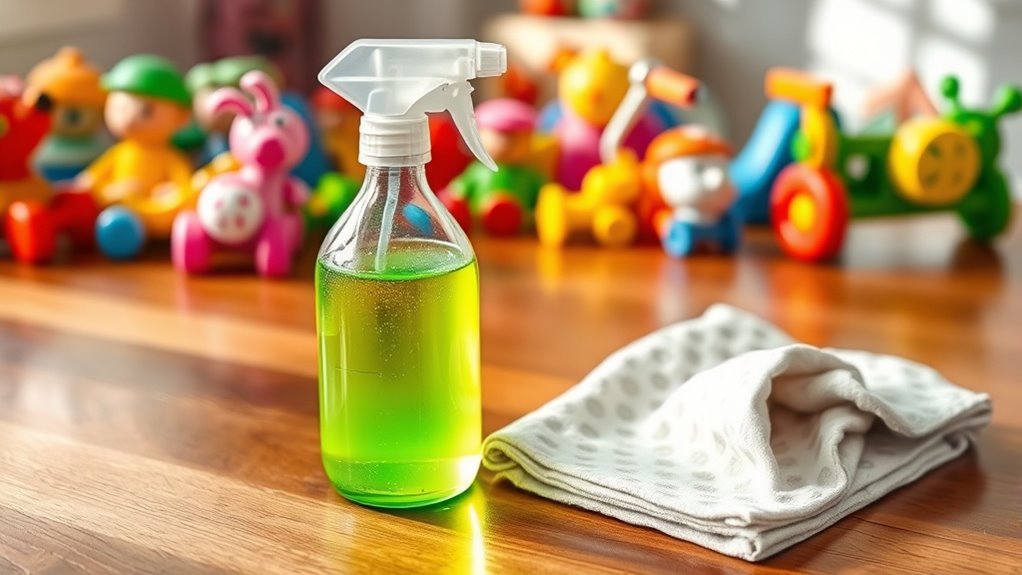
Although commercial toy cleaners are widely available, using homemade cleaners offers several advantages you’ll appreciate. When you make your own, you gain freedom from harsh chemicals that harm the environment, reducing your ecological footprint. You can control exactly what goes into your cleaner, ensuring it’s safe for your kids and the planet. Plus, homemade cleaners are remarkably cost effective—you’ll save money by using simple, everyday ingredients instead of pricey store-bought products. This approach not only gives you financial freedom but also lessens waste from packaging. Choosing homemade means you’re making a sustainable, budget-friendly decision that aligns with your values. It’s a small change with a big impact, giving you peace of mind and a cleaner, greener home for your family.
Essential Ingredients for DIY Toy Surface Cleaners
Making your own toy cleaner means you get to choose ingredients that are safe and effective. You can embrace eco friendly alternatives that protect both your child’s health and the environment. Considering cleaning frequency, it’s smart to pick gentle yet powerful components to avoid damaging toy surfaces over time. Here’s a quick look at essential ingredients:
| Ingredient | Purpose | Benefits |
|---|---|---|
| Baking Soda | Mild abrasive | Removes stains naturally |
| Castile Soap | Cleansing agent | Biodegradable, non-toxic |
| Essential Oils | Antimicrobial scent | Adds freshness, safe |
| Distilled Water | Diluent | Prevents residue buildup |
| Witch Hazel | Antiseptic | Speeds up drying |
Choosing these lets you tailor your cleaner, giving you freedom from harsh chemicals.
How to Make a Gentle Vinegar-Based Toy Cleaner
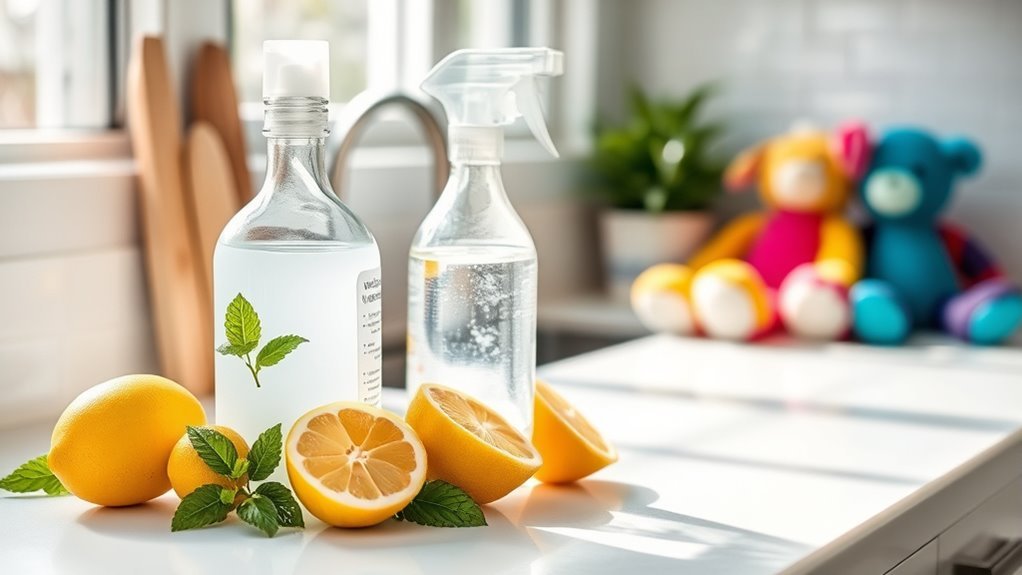
One simple recipe you can try combines just a few ingredients to create a gentle vinegar-based cleaner that’s safe for most toy surfaces. Start with one cup of distilled white vinegar, a natural disinfectant, and mix it with one cup of water to dilute its strength. Add a teaspoon of mild liquid soap to help lift grime without harsh chemicals. This blend offers eco friendly options that protect both your child and the environment. Pour the solution into a spray bottle for easy application. Just spray onto the toy surface, wipe with a soft cloth, and let it air dry. This child safe solution avoids toxins, giving you peace of mind while keeping toys clean and fresh. It’s a simple way to embrace freedom in your cleaning routine.
Using Baking Soda for Tough Toy Stains
If you’re dealing with stubborn stains on your child’s toys, baking soda can be a real lifesaver thanks to its gentle abrasive properties. You’ll want to apply it carefully, maybe as a paste with water, to scrub away grime without damaging the surface. Just make sure to rinse thoroughly afterward to keep the toys safe and residue-free.
Baking Soda Cleaning Benefits
When you’re tackling tough toy stains, baking soda can be a surprisingly effective ally. Its natural abrasiveness combined with gentle cleaning power makes it ideal for freeing your toys from grime without harsh chemicals. The baking soda uses go beyond simple scrubbing — it deodorizes and brightens, giving your toys a fresh feel.
Here’s why you’ll love the baking soda benefits for your cleaning freedom:
- Removes stubborn dirt without damaging surfaces
- Neutralizes odors, keeping toys smelling fresh
- Safe and non-toxic, perfect for kids’ playthings
Application Techniques for Stains
Although baking soda is gentle, it’s powerful enough to tackle tough toy stains with the right techniques. You’ll want to sprinkle baking soda directly onto the stain, then add a few drops of water to form a paste. Let it sit for 10-15 minutes before scrubbing gently with a soft brush. This method enhances stain removal without harsh chemicals. Adjust your cleaning frequency based on how often toys get dirty—frequent touch-ups keep stains manageable.
| Step | Action |
|---|---|
| 1 | Sprinkle baking soda |
| 2 | Add water to form paste |
| 3 | Let sit 10-15 minutes |
| 4 | Gently scrub with soft brush |
| 5 | Rinse and dry thoroughly |
This technique gives you freedom from tough stains without compromising safety.
Safety Tips for Toys
Using baking soda to clean toy stains is effective, but you’ll want to keep a few safety tips in mind to protect both the toys and those who use them. Prioritize toy hygiene by ensuring that the baking soda paste is thoroughly rinsed off to prevent ingestion or irritation. Maintain a sensible cleaning frequency—over-cleaning can wear down delicate surfaces, while under-cleaning risks bacteria buildup. Finally, test the baking soda mixture on a small, hidden area first to avoid damage.
- Use lukewarm water for rinsing to protect toy materials
- Avoid harsh scrubbing that might scratch or degrade surfaces
- Store cleaned toys in a dry, ventilated place to prevent mold
These steps keep your toys safe, clean, and ready for carefree play.
Natural Disinfectants Safe for Kids’ Toys
Because kids put their toys in their mouths and handle them constantly, choosing natural disinfectants is a smart way to keep those surfaces clean without exposing your little ones to harsh chemicals. You want eco friendly alternatives that won’t compromise safety or effectiveness. Simple ingredients like white vinegar, baking soda, and a few drops of tea tree oil make great toddler safe ingredients. They clean well, kill germs, and won’t leave harmful residues behind. Just mix vinegar and water in a spray bottle for an easy, non-toxic solution. Avoid bleach or synthetic fragrances that can irritate sensitive skin or respiratory systems. By opting for these natural options, you’re giving your child a cleaner play environment while maintaining freedom from toxic substances. It’s a win-win for peace of mind and your family’s health.
Cleaning Wooden Toys Without Damaging the Finish
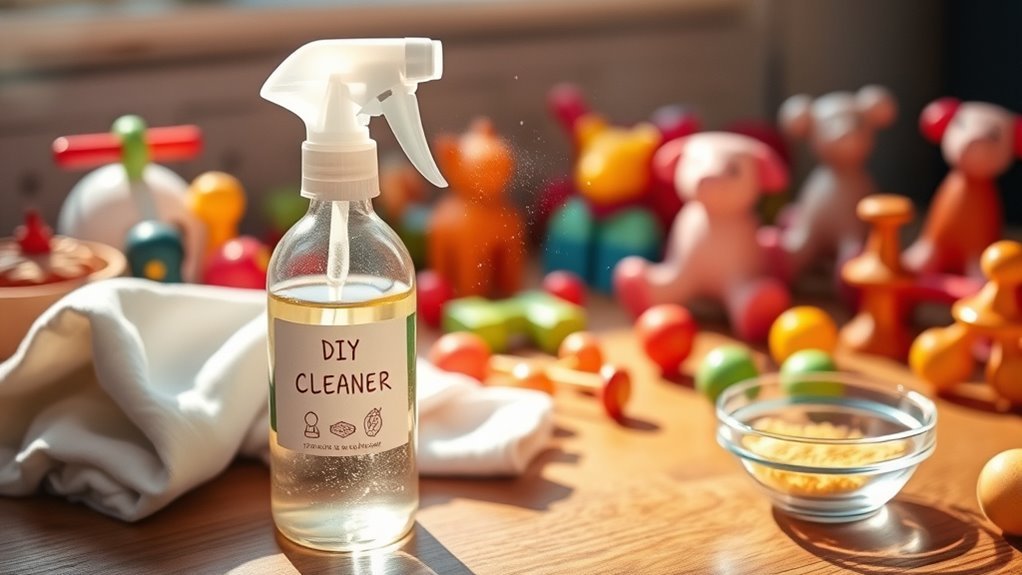
When cleaning wooden toys, you’ll want to use gentle methods to protect their finish. Harsh chemicals or excessive moisture can cause damage, so choosing the right approach is key. Let’s explore how to keep those toys clean while maintaining their natural beauty.
Gentle Cleaning Methods
Although wooden toys are durable, they require gentle cleaning to preserve their finish and natural beauty. You want to choose eco friendly options that respect both the wood and the environment. When cleaning, consider surface compatibility to avoid damage or discoloration. Here’s how you can keep your wooden toys fresh without compromising their finish:
- Use a soft cloth dampened with a mild soap solution to gently wipe the surface.
- Avoid soaking the wood; excess moisture can cause warping or cracking.
- Opt for natural oils like beeswax or coconut oil to condition the wood after cleaning.
With these simple methods, you maintain your child’s toys safely and sustainably, freeing you from harsh chemicals while keeping the wood’s charm intact.
Maintaining Wood Finish
To keep wooden toys looking their best, you’ll want to clean them carefully without stripping away their finish. Start by using a mild soap diluted in water and a soft cloth to gently wipe the surface. Avoid soaking the wood, as excess moisture can damage the finish and the wood itself. For finish protection, consider applying a natural oil like mineral or beeswax occasionally to nourish the wood and maintain its sheen. This simple wood care routine not only preserves the toy’s appearance but also extends its life, letting you enjoy its charm freely. Remember, harsh chemicals or abrasive scrubbing can ruin the finish, so keep your cleaning method gentle and minimal. With the right care, your wooden toys stay beautiful and ready for play.
Tips for Sanitizing Fabric and Plush Toys
Since fabric and plush toys can easily trap dirt and germs, it’s important you sanitize them regularly to keep your child’s playthings safe and clean. For effective fabric sanitation and plush toy care, follow these simple tips that free you from harsh chemicals and complicated routines:
- Spot clean stains immediately with a mild soap solution to prevent buildup.
- Use a gentle, fragrance-free detergent and wash plush toys in cold water on a delicate cycle.
- Air dry thoroughly in a well-ventilated area to avoid moisture retention, which can cause mold.
Step-by-Step Guide to Making a Citrus-Infused Cleaner
You’ll need just a few simple ingredients to make your citrus-infused cleaner, like lemon peels, vinegar, and water. Start by infusing the citrus peels in vinegar for a week to extract all the natural oils. Once ready, you’ll learn how to apply this cleaner safely and effectively on your toy surfaces.
Essential Ingredients Overview
Three essential ingredients make up a simple yet effective citrus-infused cleaner for toy surfaces. Choosing eco friendly options lets you keep your space clean without compromising your values or the planet’s health. Plus, understanding the right ingredients helps you adjust cleaning frequency based on your needs.
Here’s what you’ll need:
- Fresh citrus peels (lemon or orange) for natural antibacterial power and a revitalizing scent
- White vinegar, a powerful, non-toxic disinfectant that cuts through grime
- Distilled water to dilute and balance the solution, ensuring it’s safe for frequent use
With these ingredients, you create a versatile cleaner that respects your desire for freedom and control over what touches your toys—clean when you want, with safe, natural components.
Preparation and Infusion Process
Now that you know the key ingredients, it’s time to prepare your citrus-infused cleaner. Start by washing and drying your citrus peels thoroughly to remove any dirt or pesticides. Choose your infusion method: either cold infusion by soaking peels in vinegar for 1-2 weeks or quick hot infusion by simmering peels in vinegar for about 30 minutes. Both techniques extract essential oils that boost cleaning power. After infusing, strain the mixture to remove solids, ensuring a clear, ready-to-use cleaner. Use a clean glass jar for storage to maintain purity and avoid chemical reactions. These preparation techniques are simple but vital—they guarantee your DIY cleaner is both effective and safe for toy surfaces, giving you freedom from harsh chemicals while keeping playtime safe and clean.
Application Tips for Toys
Before applying your citrus-infused cleaner to toy surfaces, make certain the toys are free of loose dirt or debris by wiping them down with a dry cloth. This simple step guarantees the cleaner works effectively and protects the toy’s finish. When using your DIY cleaner, follow these toy cleaning techniques for the best results:
- Spray the cleaner lightly onto a soft cloth instead of directly on the toy to avoid oversaturation.
- Gently wipe the toy’s surface, focusing on crevices where dirt hides.
- Allow the toy to air dry fully before putting it away or letting kids play.
For cleaning frequency recommendations, aim to clean toys weekly or after heavy use. This routine keeps toys fresh and safe while giving you freedom from harsh chemicals.
Storing and Using Your Homemade Toy Cleaner Safely
Although homemade toy cleaners are often made from simple, non-toxic ingredients, you should always store them in clearly labeled, airtight containers away from children and pets to prevent accidental ingestion or spills. Safe storage isn’t just about keeping your cleaner secure—it’s about preserving its effectiveness and avoiding contamination. Use proper labeling to identify your cleaner clearly, including the date you made it, so you know when it’s time to refresh your batch. When using your DIY cleaner, apply it in well-ventilated areas and avoid mixing it with other chemicals to maintain its purity. By following these straightforward steps, you’ll enjoy the freedom of making your own cleaner while keeping your home safe and your toys sparkling clean.
Troubleshooting Common Cleaning Challenges on Toy Surfaces
When you’re cleaning toys, you might run into stubborn stains, sticky residues, or delicate surfaces that don’t respond well to standard methods. Don’t worry—you can tackle these challenges while keeping surface protection in mind. For effective stain removal and care, try these tips:
- Use a soft cloth dampened with diluted DIY cleaner for delicate surfaces to avoid damage.
- Apply a paste of baking soda and water on tough stains, let it sit briefly, then gently scrub.
- For sticky residues, a small amount of white vinegar can dissolve the mess without harming the toy’s finish.
Frequently Asked Questions
Can DIY Toy Cleaners Remove Mold and Mildew Effectively?
You might wonder if DIY toy cleaners can tackle mold removal and mildew prevention effectively. They actually can, as many homemade solutions use natural antifungal ingredients like vinegar or baking soda, which break down mold and stop mildew from coming back. You’re free to customize these cleaners with what you have, giving you control over chemicals and safety while keeping toys fresh and clean without relying on harsh commercial products.
Are Homemade Cleaners Safe for Electronic Toy Components?
You might worry homemade cleaners won’t meet safety standards for electronic components, but you can absolutely keep your toys safe if you’re careful. Avoid soaking or using too much liquid—damp cloths with gentle, non-corrosive solutions work best. This way, you maintain freedom to clean without risking damage. Just remember, controlling moisture is key to protecting delicate electronics while still enjoying a natural, DIY approach.
How Often Should I Clean My Child’s Toys With DIY Solutions?
You should aim for daily cleaning to keep toy hygiene in check, especially for items your child uses often. This helps reduce germs and keeps playtime safe and fun. Of course, you don’t need to deep clean every day—just a quick wipe-down with your DIY solution works wonders. This approach lets you enjoy the freedom of knowing the toys are fresh without feeling overwhelmed by constant scrubbing.
Can These Cleaners Be Used on Outdoor Toys and Playground Equipment?
You might think outdoor toys and playground equipment need tough, commercial cleaners, but you can actually use gentle DIY solutions safely. They’re perfect for maintaining playground maintenance without harsh chemicals, supporting outdoor safety for your kids. Since you’re aiming for freedom from toxins and expensive products, these cleaners let you enjoy playtime worry-free. Just make sure to rinse surfaces well and avoid materials that might be sensitive to moisture or vinegar-based solutions.
What Are the Environmental Impacts of Homemade Toy Cleaning Ingredients?
When you choose natural ingredients for cleaning, you’re opting for eco friendly alternatives that minimize harm to the environment. These substances break down more easily and don’t leave behind toxic residues, so you’re protecting water sources and wildlife. By avoiding harsh chemicals, you’re embracing freedom from pollutants and supporting a healthier planet. It’s a simple way to keep things clean while staying aligned with your values of sustainability and care.
